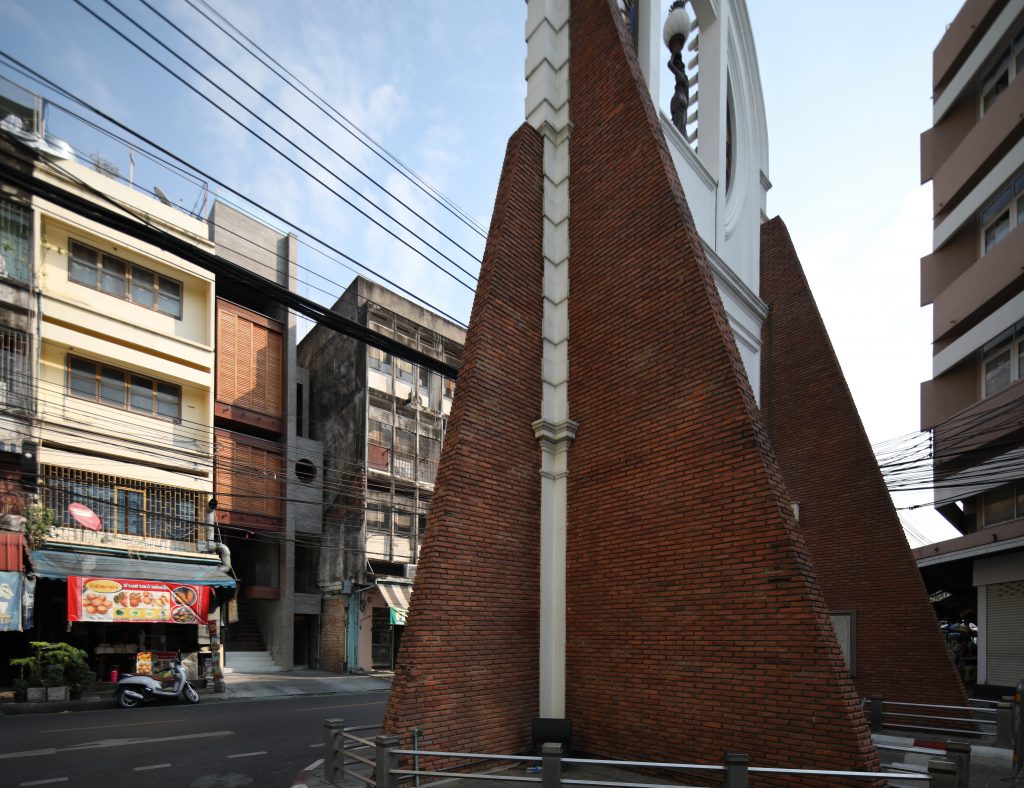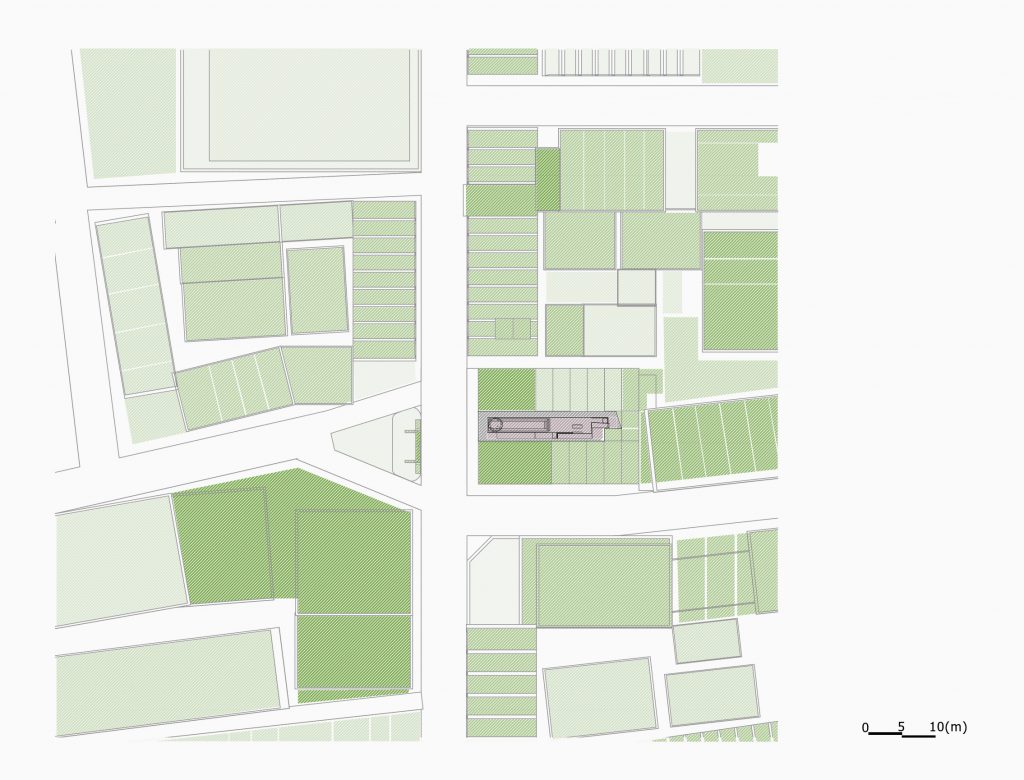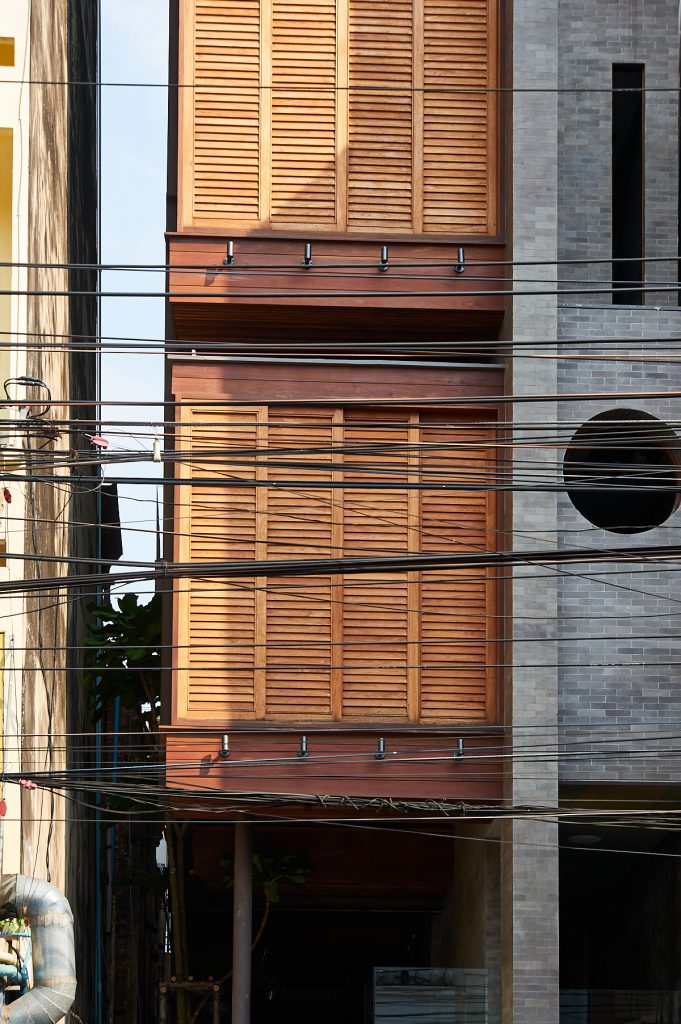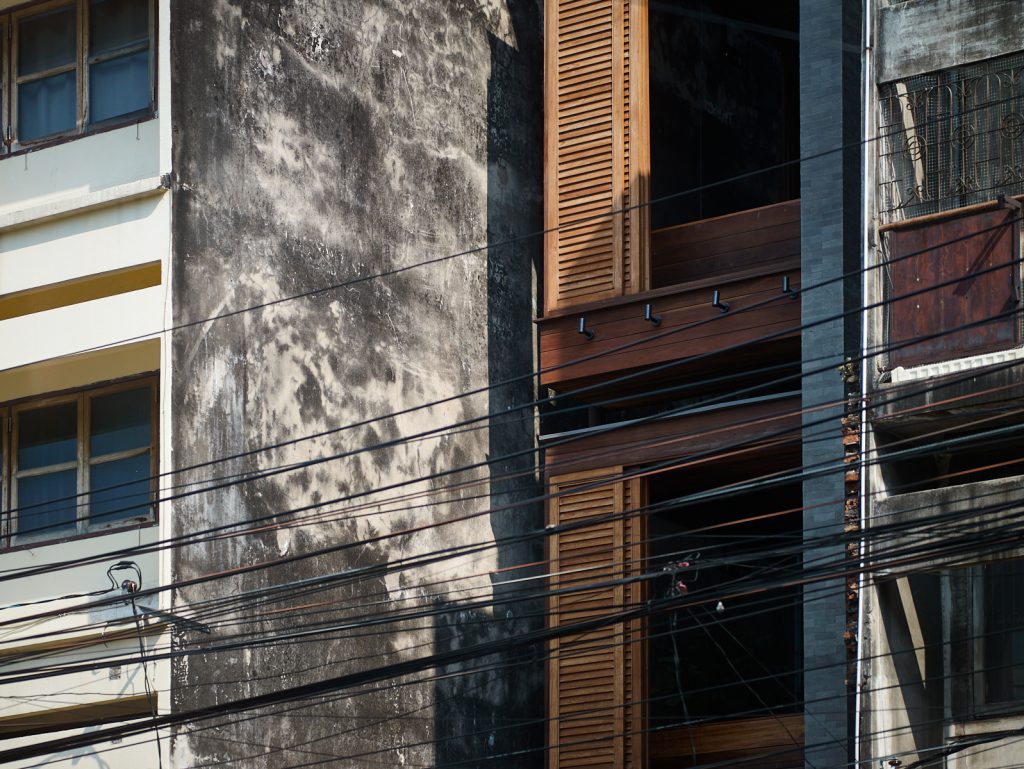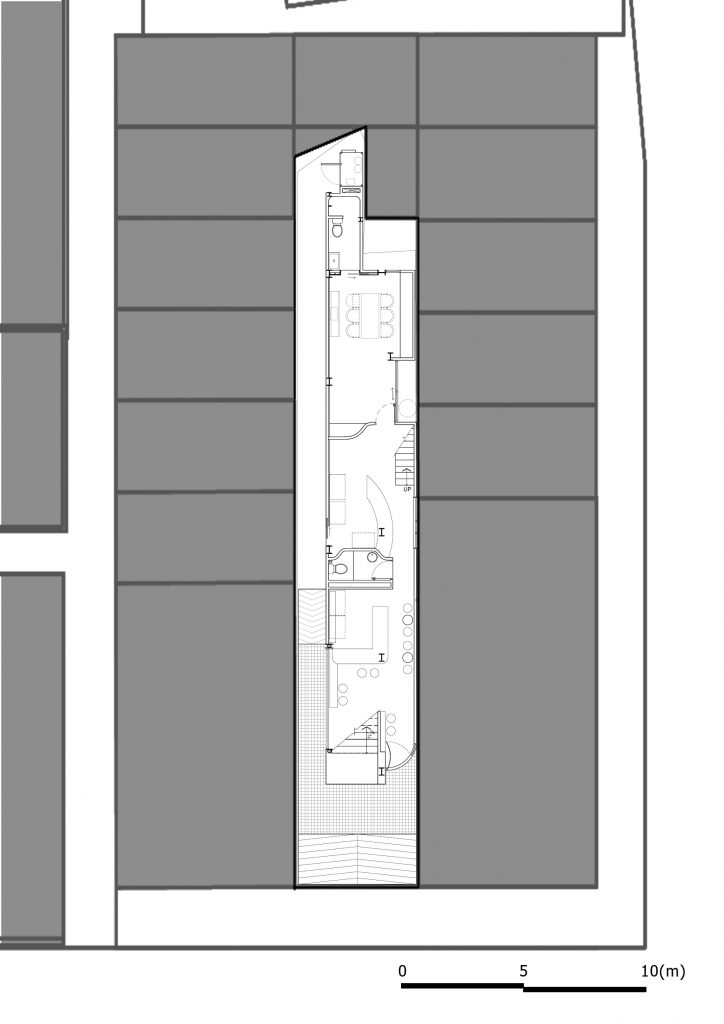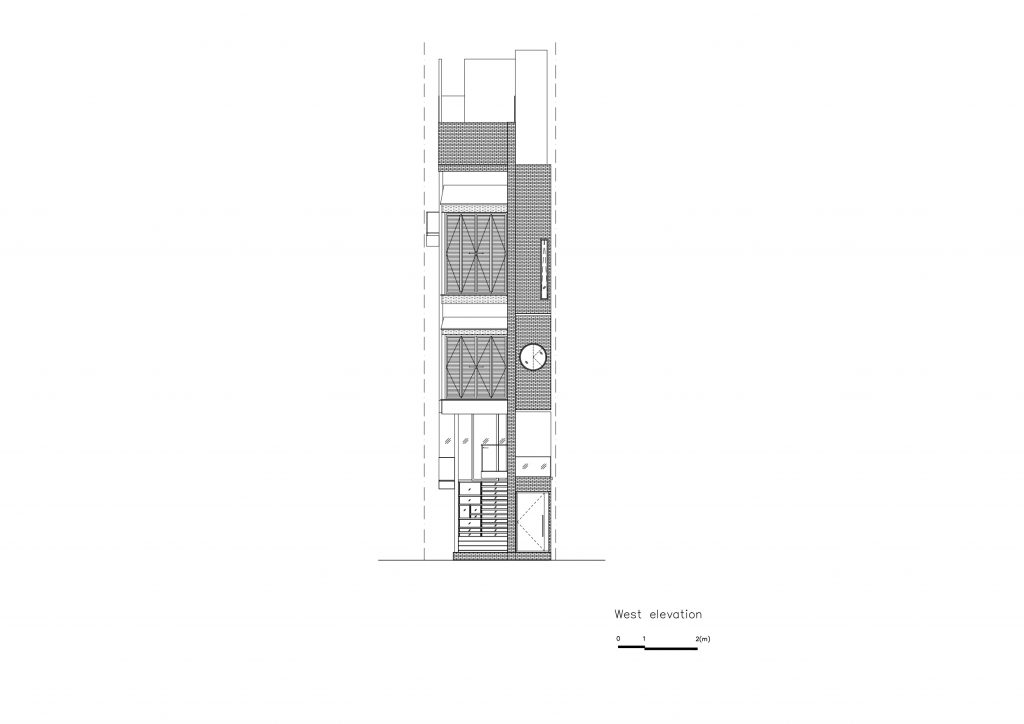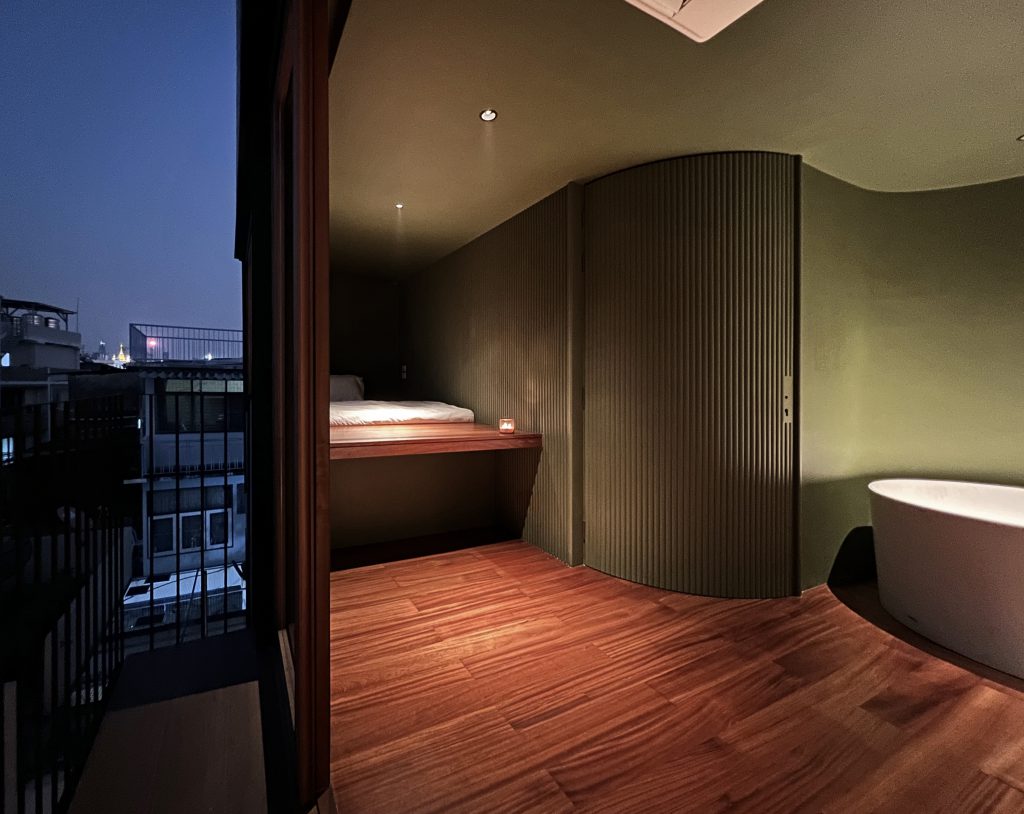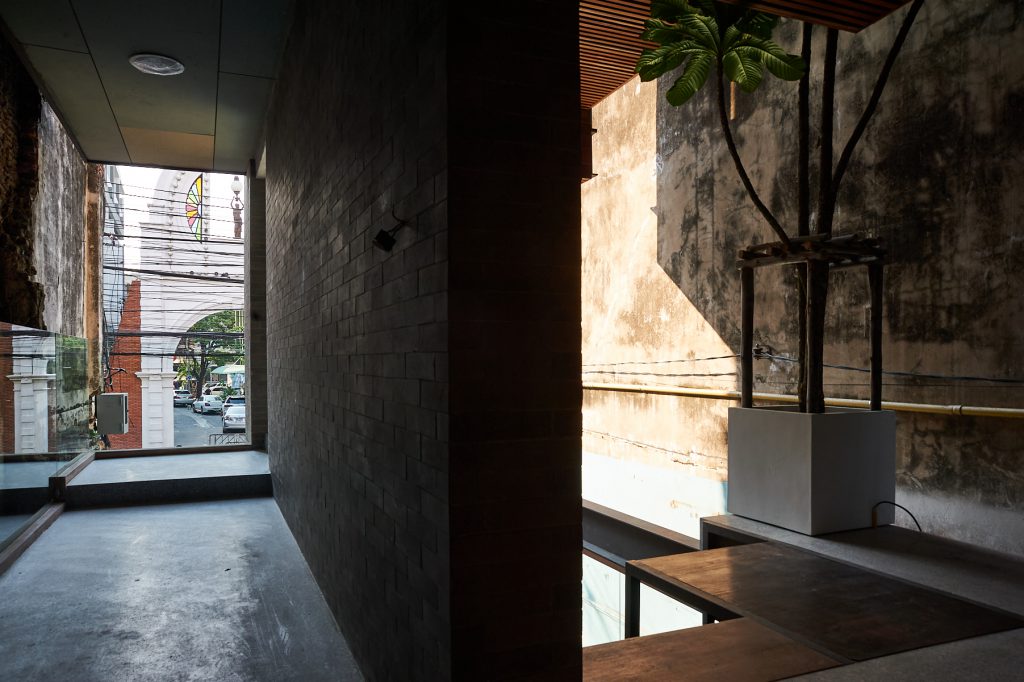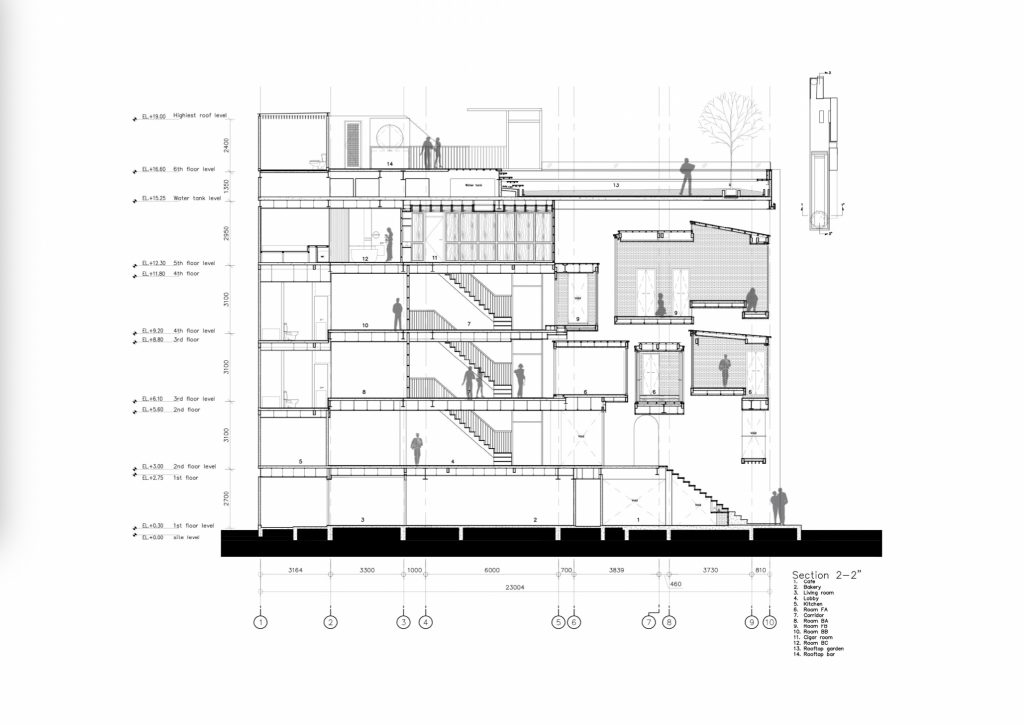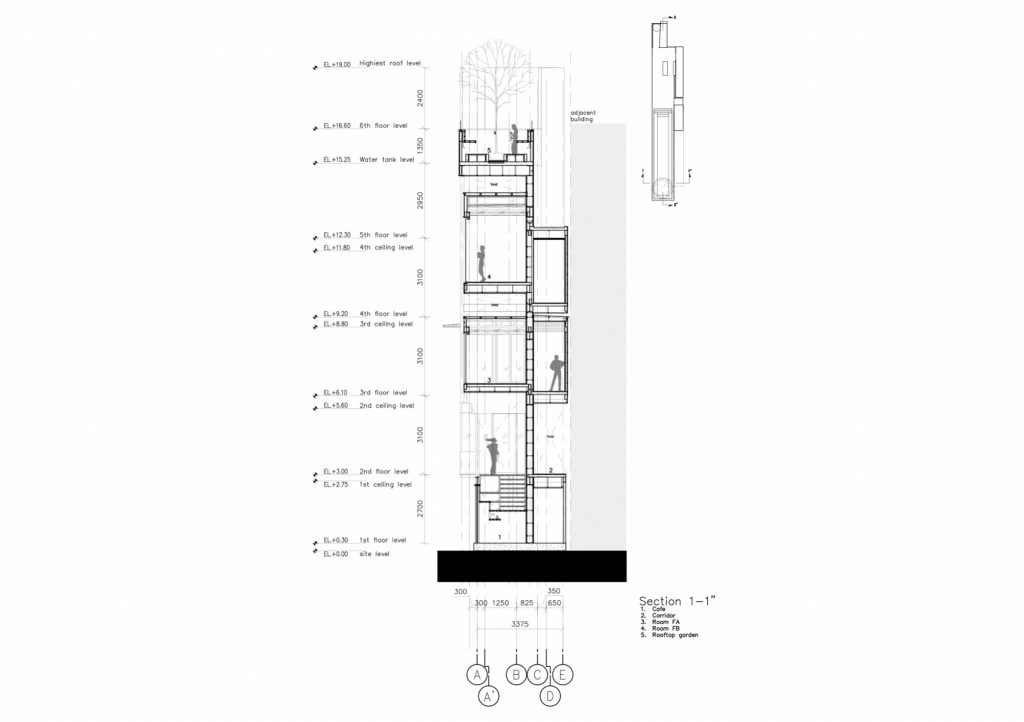Na Tanao is a tiny building in the old city area nested between built structures on a small piece of land only 3.50 meters wide.
Text: Xaroj Phrawong
Photo Courtesy of P.O.AR (Patchara + Ornnicha ARchitecture Co., Ltd.)
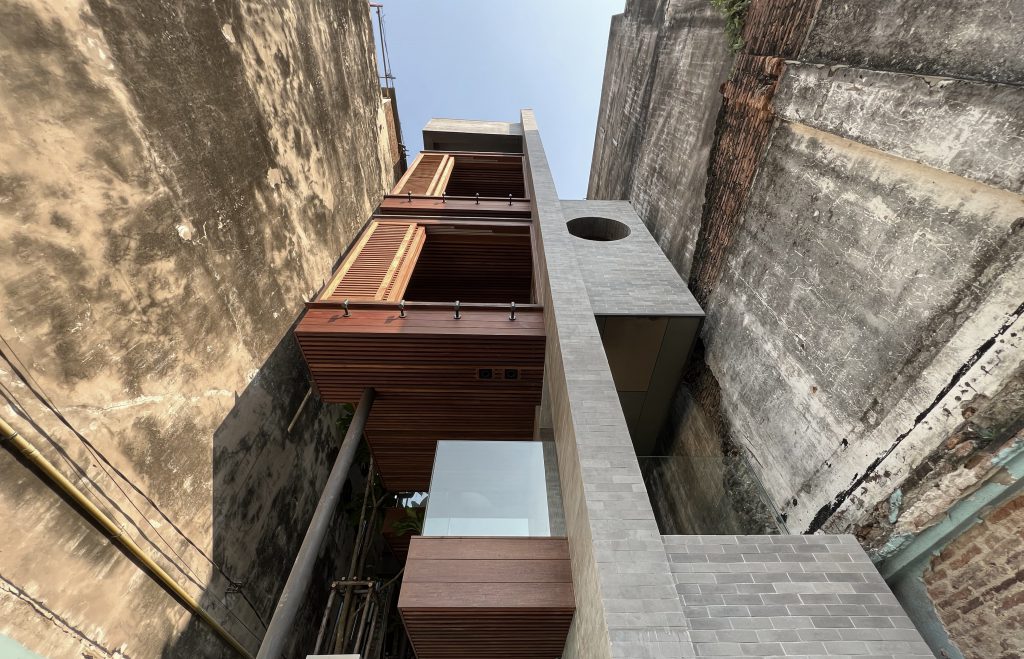
สถาปัตยกรรมในพื้นที่เมืองเก่าที่มีประวัติศาสตร์มีข้อจำกัดหลายประเด็น พอเรามองไปถึงการสร้างสรรค์สิ่งใหม่เข้าไปแทรกในความเก่าของเมือง จะพบกับข้อจำกัดที่ต้องคำนึงมากมาย การหาคำอธิบายที่ชวนให้เห็นภาพคือการเข้าใจกับบริบท เข้าใจโจทย์ของแต่ละโปรแกรม เงื่อนไขของแต่ละถิ่นที่ บริบทจึงเป็นสิ่งที่สถาปนิกต้องทำการค้นคว้าให้มีความเข้าใจเพียงพอ ก่อนที่จะลงมือออกแบบ ในประเด็นของบริบทประกอบไปด้วยทั้งแบบที่เป็นกายภาพ และไม่เป็นกายภาพ ดังเช่นพื้นที่อย่างเกาะรัตนโกสินทร์ที่มากมายด้วยบริบททั้ง กฏหมาย ประวัติศาสตร์ วัฒนธรรม
เกาะรัตนโกสินทร์เกิดขึ้นจากการที่พัฒนาพื้นที่บางกอกให้กลายเป็นกรุงเทพมหานคร แบ่งออกเป็นพื้นที่เกาะรัตนโกสินทร์ชั้นใน มีแม่น้ำเจ้าพระยา และคลองหลอดเป็นขอบเขต ส่วนเกาะรัตนโกสินทร์ชั้นนอก มีขอบเขตเป็นคลองคูเมืองเดิม คลองรอบกรุง แม่น้ำเจ้าพระยา ในย่านที่มีกิจกรรมค้าขายคึกคัก พร้อมกับแหล่งท่องเที่ยว ตั้งอยู่ในส่วนเกาะรัตนโกสินทร์ชั้นนอก เช่นย่านข้าวสาร แพร่งสรรพศาสตร์ เมื่อเราเดินสำรวจเมืองส่วนนี้ จะสามารถพบร่องรอยการทับถมของสถาปัตยกรรมเก่าปะทะใหม่กันเป็นเรื่องปรกติ คำถามที่น่าสนใจสำหรับการมองย่านนี้คือจะวางของใหม่ให้อยู่ร่วมกับของเก่าได้เหมาะสมอย่างไร ณ แพร่งสรรพศาสตร์ ในย่านถนนตะนาว มีอาคารใหม่แทรกตัวอยู่ในซอกที่ดินแคบ ด้านหน้าอาคารที่ปรากฏกว้างเพียง 3.50 เมตร ชวนให้ดูสงสัยถึงกิจกรรมภายใน ด้วยลักษณะของรูปทรงสูงแคบ สีของเปลือก ที่ต่างบริบทโดยรอบ อาคารนี้คือ ณ ตะนาว ออกแบบโดย P.O.AR (Patchara + Ornnicha Architecture Co., Ltd.)
ที่ดินของ ณ ตะนาว มีลักษณะแคบยาว ขนาดหน้ากว้าง 5.00 เมตร ลึกราว 30 เมตร ที่ดินเป็นที่ดินซึ่งตั้งอยู่ระหว่างห้องแถวเก่าด้านทิศเหนือและใต้ประจันหน้าเข้าหาที่ดิน ด้วยลักษณะเฉพาะของที่ดินแปลงนี้ซึ่งพัฒนาเป็นอสังหาริมทรัพย์ได้ยาก ทำให้เจ้าของที่ดินรุ่นก่อนไม่สนใจพัฒนาที่ดินเดิม ที่ดินนี้จึงถูกทิ้งร้างกลายเป็นที่เก็บรถเข็นขายอาหาร พื้นที่ทำอาหาร พื้นที่ซักล้างของตึกแถวโดยรอบ จนที่ดินแปลงนี้ได้สืบทอดมาถึงเจ้าของรุ่นปัจจุบัน จึงได้ตัดสินใจพัฒนาที่ดินให้มีการใช้สอยสูงสุดตามที่กฏหมายจะพึงทำได้ โปรแกรมที่เกิดขึ้นมาประกอบไปด้วยโรงแรมและบ้านเจ้าของโครงการ จำนวน 5 ห้อง ชั้นที่ 1-2 เป็นร้านอาหาร โดยแบ่งพื้นที่บางส่วนชั้นที่ 2 เป็นส่วนต้อนรับของโรงแรม ชั้นที่ 3-4 เป็นห้องพักลูกค้า ชั้นที่ 5 เป็นบ้านเจ้าของโครงการ และชั้นดาดฟ้าเป็นเลานจ์
การออกแบบคือการแก้ปัญหา การแก้ปัญหาที่ดีสามารถแสดงได้ถึงความฉลาดในการเลือกวิธีการด้วยเช่นกัน จากปัญหาของโปรแกรมที่มีความหลากหลาย ปัญหาของรูปที่ดินแคบลึก ทำให้การออกแบบงานนี้เป็นโจทย์ที่ยาก การเลือกหาคำตอบจากปัญหาจึงเป็นสิ่งสำคัญยิ่งยวด เมื่อมองไปยังผลงานออกแบบนี้ ได้พบการแก้ปัญหาที่น่าสนใจจากการบริการพื้นที่ที่มีอย่างจำกัด ทำให้ห้องพักที่แคบเพียง 2.50 เมตร ไม่รู้สึกอึดอัด ด้วยการใช้การออกแบบสถาปัตยกรรมอย่างฉลาดมาจัดการ การแก้ปัญหาจากบริบทเป็นวิธีการออกแบบสำหรับงานนี้ โดยเป็นบริบทจากภายในที่ตั้ง และบริบทจากย่านถนนตะนาว ประเด็นบริบทจากภายในที่ตั้งมาจากปัญหาที่ดินมีลักษณะแคบยาวในแนวทิศตะวันออกและตะวันตก อีกทั้งยังมีตึกแถวสูง 5 ชั้นขนาบทั้งด้านทิศเหนือและใต้ ทำให้แสงอาทิตย์ส่องลงมายังที่ดินได้ในช่วง 11.00-13.00 ซึ่งเป็นเวลาที่น้อยมาก เมื่อพิจารณาถึงปัญหาที่จะตามมาจากการขาดแสงธรรมชาติ ทำให้กำหนดแนวทางการออกแบบให้การออกแบบผัง และสเปซภายใน ถูกจัดวางให้กระจายตัวจากกันทั้งในแนว 3 มิติ ยิ่งเมื่อพิจารณาจากรูปตัด จะเห็นความพยายามกระจายส่วนใช้สอยแต่ละส่วนให้มีความเหลื่อมกัน เพื่อให้อากาศไหลเวียนจากที่ต่ำสู่ที่สูง ตามช่องขนาดเล็กที่แทรกตัวแบบกระจายตั้งแต่ชั้นที่ 1-5 ซึ่งในมุมมองของสถาปนิกคือการสร้าง ‘tropical micro-climate’ คล้ายเป็นชานบ้านในแนวดิ่ง
เมื่อเข้ามายังภายใน ช่องเปิดด้านทิศเหนือซึ่งประจันหน้ากับผนังตึกแถวเก่าเป็นสิ่งที่เชื่อมโยงความเก่าจากรอบข้าง สู่ความใหม่ของโรงแรมอย่างขัดแย้ง หน้าต่างกระจกใสเปิดเผยให้เห็นร่องรอยคราบเวลาของผนังตึกแถวที่สร้างใหม่ และตึกแถวเก่าที่สร้างในสไตล์นีโอคลาสสสิค จากปรกติที่พบเห็น มันคือส่วนที่มักจะเลือกปิดทับมันไป หรือเลือกที่ไม่เปิดหามัน แต่สถาปนิกเลือกที่จะเปิดให้เห็นอย่างชัดเจนจากในห้องพัก ให้มันกลายเป็นการสร้างประสบการณ์แก่ผู้เข้าพักที่จะได้พบกับเรื่องไม่คุ้นเคยในชีวิตประจำวัน จากการเลือกที่จะเปิดหน้าต่าง มากกว่าปิดรับภาพข้างเคียง ทำให้เกิดการสังสรรค์ของแสงในสเปซ แสงธรรมชาติเป็นอีกปัจจัยที่ถูกใช้มาให้พื้นที่แคบลดความอึดอัดลงได้ ทุกส่วนที่แม้จะแคบจากสัดส่วนปรกติได้มีแสงเข้ามาสร้างชีวิตชีวามากขึ้น เมื่อเข้ามายังสเปซภายใน จะพบกับระดับความเข้มจางของแสงที่สลับกันไปทั้งสลัวในระดับต่าง ๆ กันไปตามส่วนใช้สอย
“สิ่งที่เราสร้าง เรา absorb surrounding เวลาที่เรามาไซท์ ทุกคนมองว่ามันคือบริบทของเรา ซึ่งมันไม่มีความจำเป็นที่จะต้องบังไปเสียหมด ด้วยความที่ห้องเราแคบ การที่เราเปิด ทำให้ผู้ใช้ไม่รู้สึกอึดอัด การที่เปิด ทำให้เวิ้งนี้กลายเป็นส่วนหนึ่งของห้อง โดยคิดถึงเรื่องแสงกับลม” อรณิชา ดุริยะประพันธ์ หนึ่งในสถาปนิกจาก P.O.AR กล่าวถึงส่วนนี้
บริบทจากย่านถนนตะนาวได้ถูกนำมาแก้ปัญหาจากการเชื่อมโยงเข้ากับสเปซภายใน เนื่องจากฝั่งตรงข้ามที่ดินตั้งอยู่ตรงข้ามซุ้มประตูวังสรรพสาตรศุภกิจ ซึ่งก่อสร้างขึ้นในรัชกาลที่ 5 เมื่อราว พ.ศ. 2444 ในรูปแบบสถาปัตยกรรมตะวันตกที่นิยมกันในหมู่ชนชั้นสูงของสยามในเวลานั้น อันเป็นพยานวัตถุบอกได้ถึงอดีตอันรุ่งเรืองของย่านนี้ ในเวลาต่อมาวังสรรพสาตรศุภกิจได้ถูกขายให้เอกชน และวังได้ถูกรื้อ พัฒนาเป็นพื้นที่การค้า ซุ้มประตูวังสรรพสาตรศุภกิจเป็นประเด็นที่ถูกนำมาคิดกับการออกแบบภายนอกและภายใน พื้นที่ทางเดินภายในห้องพักชั้นที่ 3 เป็นจุดที่อยู่ตรงกับระดับความสูงของยอดซุ้มที่เป็นวงกลม เป็นส่วนที่สถาปนิกออกแบบช่องเปิดให้เป็นวงกลม เหมือนสถาปัตยกรรมเป็นตัวสะท้อนวงกลมจากซุ้มประตู ในส่วนห้องพักที่ชั้น 3-4 ด้านที่ประจันกับถนนตะนาว สถาปนิกได้เลือกที่จะเชื่อมบริบทภายนอกเข้ามาเป็นส่วนหนึ่งของสเปซภายในจากการให้ส่วนห้องนอนเป็นประตูบานเลื่อนไม้ที่สามารถปิดได้เมื่อต้องการความเป็นส่วนตัว เมื่อต้องการที่จะรับทิวทัศน์จากย่านถนนตะนาว โดยเฉพาะซุ้มประตูวังสรรพสาตรศุภกิจ บานเลื่อนไม้สามารถเปิดออกได้จนสุด ทำให้สามารถนั่งนอนชมทิวทัศน์ของถนนตะนาวทั้งในเวลากลางวันและกลางคืนจากเตียงนอน นอกจากการเลือกใช้บริบทมาสู่การออกแบบสเปซ ช่องแสงแล้ว ประเด็นการเลือกใช้เปลือกภายนอกที่กรุด้วยอิฐเปลือยสีเทา ก็มาจากการตีความบริบทเก่าที่ไม่อ้างอิงอดีต
“ตอนที่ออกแบบ เราไม่อยากเป็นส่วนของอดีต แต่เราก็ไม่ได้อยากเป็นอาคารที่ดูใหม่ จนไม่มีร่องรอยถึงกัน เลยเลือกใช้อิฐที่มีสัดส่วนเดียวกัน แต่ว่าคนละสี ให้ดูรู้ว่าสิ่งไหนเกิดยุคไหน” พัชระ วงศ์บุญสิน หนึ่งในสถาปนิกจาก P.O.AR กล่าวถึงส่วนนี้
วันที่ผู้เขียนได้ไปเยือนสถานที่นี้ สัมผัสได้ถึงลมที่พัดผ่านตรอกลมจากช่องแคบขึ้นมาจากด้านล่าง และพัดเร็วขึ้นที่ช่องเปิดระหว่างทางเดิน ทำให้รู้สึกสบายตัวขึ้น ในวันที่กรุงเทพมหานครมีอุณหภูมิร้อนแบบปรกติ และรู้สึกได้ถึงเรื่องราวย่านเก่าสู่สถาปัตยกรรม
Architecture in a historical town or city is often bound by limitations. When a new structure is created as a part of a city’s historical urban fabric, countless restrictions need to be put into consideration. Trying to come up with a concrete explanation is an attempt to understand the context, the brief that comes with each program, and conditions attached to each locality. Context is, therefore, something architects need to research and have enough understanding in before carrying on with the design process. The contextual issues include physical and non-physical things, just like how Rattanakosin Island is filled to the brim with legal, historical and cultural contexts.
Rattanakosin Island was conceived from a land development plan that ended up turning the old Bangkok into the new Bangkok, which was divided into the inner Rattanakosin Island bordered by the Chao Phraya River and Khlong Lod Canal. The outer ring of Rattanakosin Island was defined by the waterways of Khlong Ku Mueang Doem and Khlong Rop Krung Canal as well as the Chao Phraya River. The areas with bustling commercial activities and traveling destinations are located on the outer periphery of the island such as Khao San Road, Prang Sappasart, etc. While strolling through this part of the city, superimposed traces of old and new architecture are common encounters. An interesting question that arises from examining the neighborhood is how something new can be added to something old without ruining the charm and historical backdrop. At Prang Sappasart neighborhood on Tanao road sits a new building, nested between built structures, on a small piece of land that is only 3.50 meters wide. With its tall, narrow shape, and color that sets the place apart from its neighboring buildings, one cannot help but wonder about what’s going on inside this new establishment. The building is called Na Tanao and it is designed by P.O.AR (Patchara + Ornnicha Architecture Co., Ltd.)
The long and narrow piece of land is five meters wide and 30 meters deep. The land is situated between old row houses located towards the north and south, directly facing the site. The land’s special characteristics made a new development highly challenging. The previous generations of owners didn’t care much about the land, leaving it as a parking space for local food kiosks, as well as a cooking and wash areas for tenants living in the neighboring row of houses. Once the building was inherited, the current owner decided to develop it into an establishment with maximized functionalities that the laws and regulations would allow. The new program is born as a five-room building that includes the functionality of a hotel and the owner’s living space.
The first and second floor houses a restaurant with a portion of the second floor used as the hotel’s reception area. The third and fourth floor is where the hotel rooms are located with the fifth floor that is home to the owner’s living spaces and the hotel’s lounge occupying the rooftop. Design is about finding a solution. A good solution is a reflection of how cleverly the decisions are made and the methods devised. The diversity of the program and the narrow and deep shape of the land are what make the design challenging. Searching and choosing the right answer to solve the problems, therefore, are vital. The project showcases some interesting problem solving approaches from an attempt to manage the limited usable spaces. The 2.50-meter wide hotel rooms doesn’t feel as confined as they may seem thanks to the smart architectural design. Finding a solution from the contexts is the approach taken with this project be it the context of the site itself or that of Tanao road.
The site is not only long and narrow but has five story high shophouses sandwiching both the north and south side of the land. This means the site will have only two hours of sunlight between 11.00 and 13.00, which is a very small window of time considering all the problems that follow the lack of natural light. The design scatters the floor plan and interior spaces in three dimensional directions. Looking at the section, one can see the attempt to distribute functional spaces to overlap, enabling air circulation between the lower and upper floors, through sporadic small openings on all the five floors. The architects refer to the design as a creation of ‘tropical micro-climate’ or a series of vertical patios.
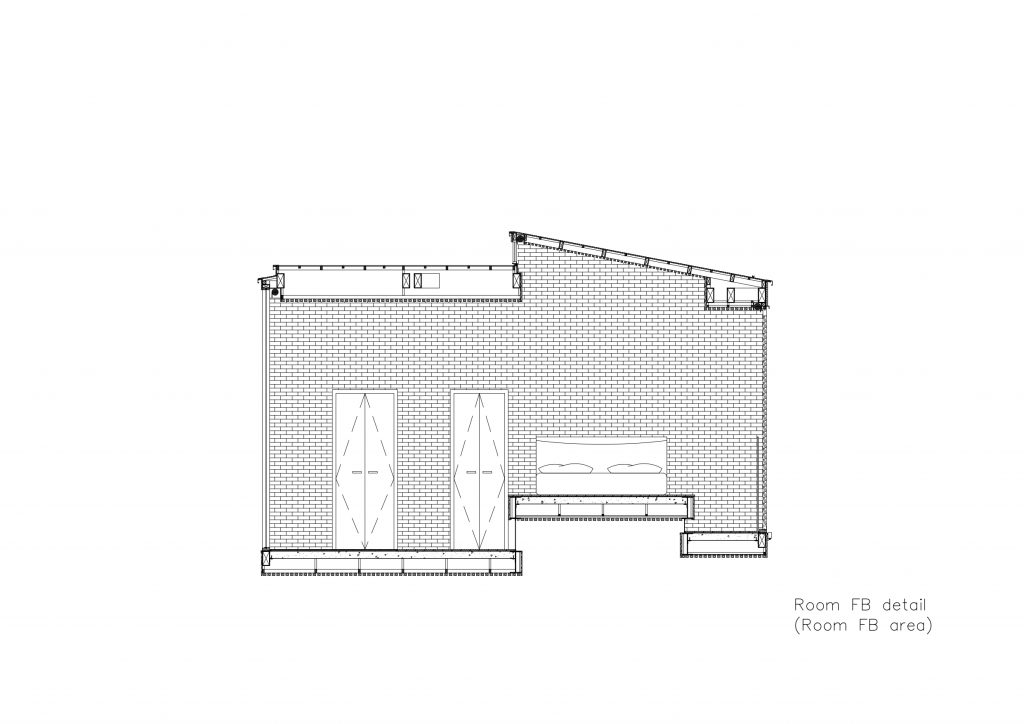
Walking inside, the openings toward the north side facing the old shophouses are what connect the oldness of the surrounding context to the newness of the establishment. The contrast is accentuated through transparent windows, revealing the traces of time on the newly constructed walls and the time-worn neo-classical shophouses. What would normally get covered up or shielded from the hotel’s guests, is revealed and granted full access to the hotel rooms. It’s the architects’ intention to curate an unfamiliar experience; one that a hotel guest may not come across in their everyday life. The decision to open the windows rather than concealing the access to the nearby environment renders a gathering of light within the space. Natural light is another factor that the architects utilize to lessen the discomfort of the rather confined space. Despite the rooms having relatively narrower and smaller proportions, the presence of natural light makes the space more alive. Once inside, one will encounter different levels of light density, varied by the nature of each functional space.
“What we create comes from how we absorb or take in from the surroundings. When we were at the site, everyone looked at it as the context we had to work with and there was no need to hide anything. With rooms being this small, opening them up make users feel more comfortable, and we ended up turning this corner of the neighborhood into a part of the rooms and staying experience with natural and wind being the factors we needed to think about,” said Ornnicha Duriyaprapan, one of the architects from P.O.AR about this particular part of the hotel.
The context of Tanao road is incorporated into the solution finding process through the way the outside surroundings are connected to the interior spaces. Opposite to the site is the entrance arch of Sappasart Suppakit Palace constructed during the reign of King Rama V, around 1901. The western-looking arch was a result of the popularity of Western architecture among the elites of Siam at the time. The built structure is also an evidence of the neighborhood’s glorious past. When the palace was sold to a private owner, which led up to it being dismantled and developed into a commercial space, the arch became a subject of interest that the design team tried to work out with the project’s exterior and interior spaces. The walkway on the third floor is at the same level as the round pinnacle of the arch.
Working around this context, the architects decided to design the round opening for this particular part of the building, reflecting the arch’s round element. The rooms on the third and fourth floor facing Tanao road are designed to have an interesting connection with the hotel’s surrounding context. The bedrooms’ sliding wooden doors can be closed if privacy is desired. If a guest wishes to open the room up for the view of Tanao road, particularly the entrance arch of Sappasart Supakit Palace, the sliding doors can be fully opened for one to sit back or lay around while enjoying the view of Tanao road during the day or at night, right from the comfort of their bed. The contextually-derived design of the spaces and openings, including the cladding material that is exposed gray bricks, were all originated from the architects’ interpretation of the old context but without any reference to the past.
“When we were working on the design, we didn’t want it to be a part of the past but we didn’t want the building to look too new that it wouldn’t show any connected traces either. So, we decided to use the type of bricks that are similar to the ones used with the older buildings, but in a different color so that there’s a distinction that indicates which period a certain creation was born,” explained Pachara Wongboonsin, one of the architects from P.O.AR about this particular detail of the design.
On the day of my visit, I could feel the wind coming through the narrow alleyway from down below and speed up as it flew through the openings at the walkway. It cooled me off on a normally hot day in Bangkok. And I could sense the story of this old neighborhood finding its way into the architecture.



